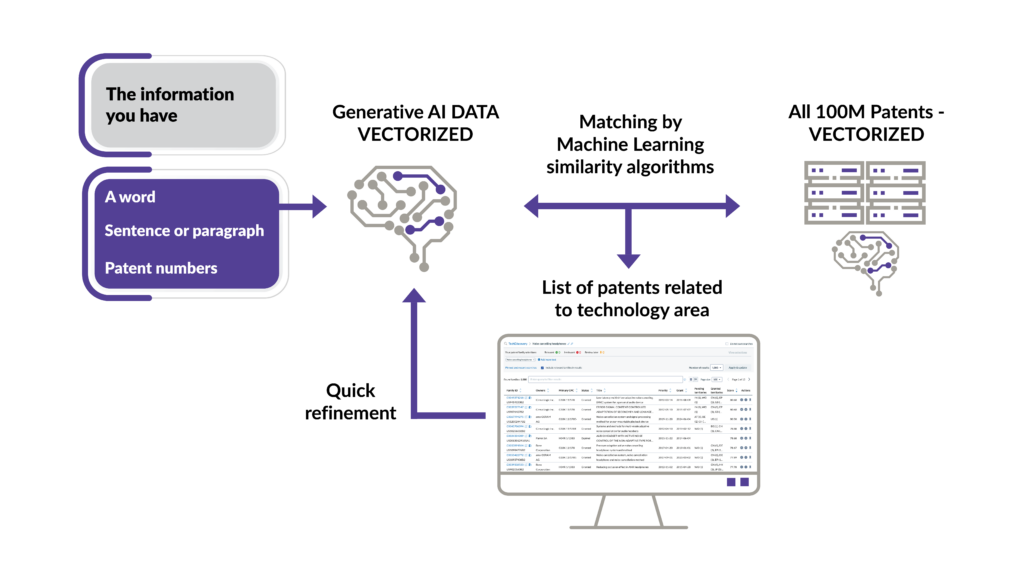AI Patent Search

A Solution Tailored for Every Team and Skill Set
Professionals across innovation teams—R&D or IP—face escalating complexities in managing and protecting intellectual property as technology companies try to maintain pace with competition and newer inventions. One of the easiest solutions to this problem is implementing AI to reduce their burdens. At the same time, the current AI solutions may not be a reliable source for insights. This is evident from recent surveys, which revealed that 74% of IP practitioners express concerns about the accuracy of AI tools. They, highlight the challenges in maintaining precision amidst rapid technological advancements. At the same time in another survey, conducted by LexisNexis, we found out that more than 60% of the respondents believe that AI will improve their efficiency and help with research.
Our latest AI patent search solution, LexisNexis® TechDiscovery, tackles these challenges by allowing users to share searches and refine results. By allowing users to select relevant or irrelevant patents, it ensures the curation of a comprehensive list of similar patents. In this blog we explore how LexisNexis TechDiscovery can solve different problems for small teams where one person is tasked with multiple functions. And how it can solve problems large teams where there are dedicated search experts.
LexisNexis TechDiscovery: Making patent search accessible
LexisNexis TechDiscovery is a revolutionary tool that simplifies the patent search process. This makes it more accessible despite experience creating complicated search queries. It was developed with two main goals in mind:
- Enable a diverse range of users, including engineers, inventors, R&D managers, IP professionals, business development managers, and patent searchers to conduct comprehensive and collaborative searches.
- Develop a versatile solution applicable across various industries, making it a valuable tool for technology screening and exploration in any field.
One of its key advantages is the ability to accept various types of input. This includes patent numbers and full-text descriptions to short phrases or even a one-word query. This flexibility allows users to explore patent information without the need for complex search techniques or Boolean queries.

Figure 1: The process followed by LexisNexis TechDiscovery to return similar patents.
LexisNexis TechDiscovery sets itself apart from other “AI-assisted” search solutions. Its ability to create comprehensive search results from low-context searches because it can search within a database of vectorized patents. For inputs that don’t contain a lot of information, such as one word or a short phrase like “noise cancelling headphones”, LexisNexis TechDiscovery creates artificial patent data based on the input. It providing enough content to vectorize and find similar patterns from a vast database of over 100 million vectorized patents. This approach ensures that the most relevant and similar patterns or patents are identified, regardless of the input format. This feature is particularly useful when users have limited experience with creating comprehensive search strings. Or if users are exploring new ideas, as it expands the search capabilities and increases the chances of discovering relevant patents.
Enabling small organizations with limited resources
For small organizations with lean IP budgets and teams, LexisNexis TechDiscovery can be a game-changer. LexisNexis TechDiscovery perfectly fits in here as it enables every team member to conduct quick and efficient research. By accepting layman’s descriptions of inventions, LexisNexis TechDiscovery can provide relevant patent patterns and language. This allows the inventor to deliver insights, e.g., the top players in a technology field, the key competitors in a region that are developing a specific technology, etc.
This enables small teams operating under restrictions to perform multiple tasks without spending a long time crafting complicated search strings for a simple search. While the searches can also be fine-tuned by team members who are more savvy about the topic, turnaround times for initial searches can be significantly reduced.
Flexibility for large enterprises with complicated innovation operations
In large enterprises with numerous R&D engineers and a high volume of innovation, patent searchers might be inundated with search requests. LexisNexis TechDiscovery democratizes this process and empowers researchers to first conduct initial searches on their own. Then they can send it to the expert searchers for additional fine-tuning and fleshing out.
Traditional patent search tools can be complex and intimidating for non-experts. Some of the searches require some level of patent-related knowledge and skills. The user-friendly interface and ability to accept natural language inputs make LexisNexis TechDiscovery accessible to R&D engineers. They can now conduct early-stage research independently. This alleviates the workload of patent search professionals. It also improves the quality of research requests they receive, as engineers can provide more informed and relevant examples.
Watch this workflow in action in our recent webinar introducing LexisNexis TechDiscovery.
Removing bottlenecks for innovation and making patent search accessible
Its primary motive is to make patent searching accessible across the innovation workflow. LexisNexis TechDiscovery significantly lowers the barrier for non-patent professionals to start engaging with patent data. This promotes collaboration across teams and improves the outcomes of collaborative endeavors. And if you are subscribed to our other services like LexisNexis TotalPatent One® or LexisNexis® PatentSight+™, subscribing to LexisNexis TechDiscovery means your searches can be directly imported for analysis in these tools to generate more insightful analysis or searches without having to export and upload multiple times.
